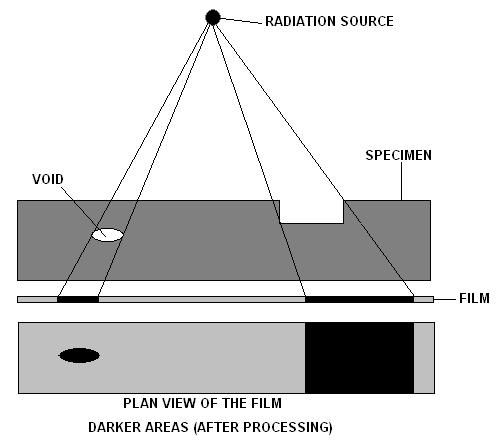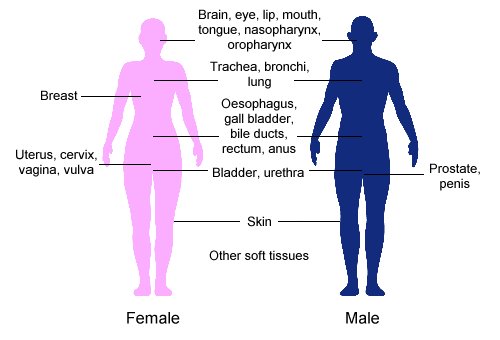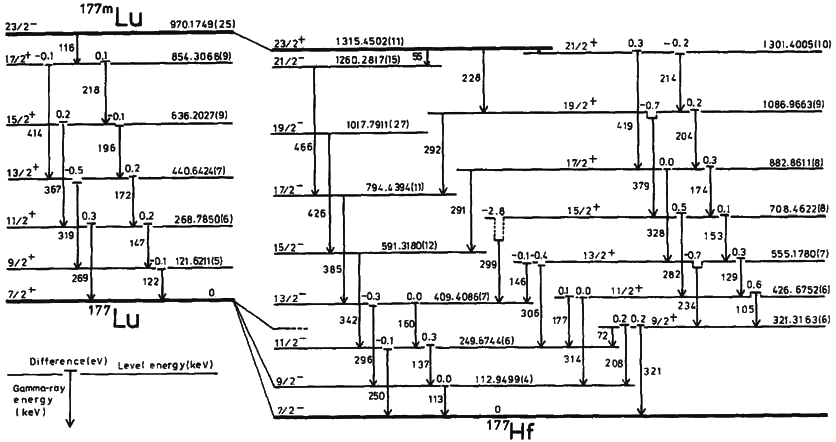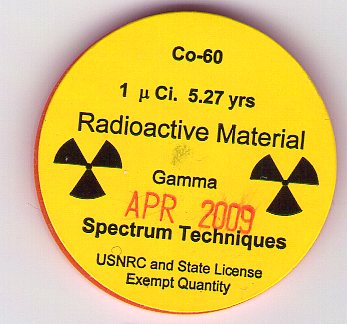|
Iridium-192
Iridium-192 (symbol 192Ir) is a radioactive isotope of iridium, with a half-life of 73.827 days. It decays by emitting beta (β) particles and gamma (γ) radiation. About 96% of 192Ir decays occur via emission of β and γ radiation, leading to 192Pt. Some of the β particles are captured by other 192Ir nuclei, which are then converted to 192Os. Electron capture is responsible for the remaining 4% of 192Ir decays. Iridium-192 is normally produced by neutron activation of natural-abundance iridium metal. Iridium-192 is a very strong gamma ray emitter, with a gamma dose-constant of approximately 1.54 μSv·h−1· MBq−1 at 30 cm, and a specific activity of 341 TBq·g−1 (9.22 kCi·g−1). There are seven principal energy packets produced during its disintegration process ranging from just over 0.2 to about 0.6 MeV. It is commonly used as a gamma ray source in industrial radiography to locate flaws in metal components. It is also used in radiotherapy as a radiation s ... [...More Info...] [...Related Items...] OR: [Wikipedia] [Google] [Baidu] |
Isotopes Of Iridium
There are two natural isotopes of iridium (77Ir), and 37 radioisotopes, the most stable radioisotope being 192Ir with a half-life of 73.83 days, and many nuclear isomers, the most stable of which is 192m2Ir with a half-life of 241 years. All other isomers have half-lives under a year, most under a day. All isotopes of iridium are either radioactive or observationally stable, meaning that they are predicted to be radioactive but no actual decay has been observed. List of isotopes , -id=Iridium-164 , 164IrDiscovery of this isotope is unconfirmed , style="text-align:right" , 77 , style="text-align:right" , 87 , 163.99197(34)# , <0.5 μs , p? , 163Os , 2−# , , , -id=Iridium-164m , rowspan=2 style="text-indent:1em" , 164mIr , rowspan=2 colspan="3" style="text-indent:2em" , 260(100)# keV , rowspan=2, 70(10) μs , p (96%) , [...More Info...] [...Related Items...] OR: [Wikipedia] [Google] [Baidu] |
Industrial Radiography
Industrial radiography is a modality of non-destructive testing that uses ionizing radiation to inspect materials and components with the objective of locating and quantifying defects and degradation in material properties that would lead to the failure of engineering structures. It plays an important role in the science and technology needed to ensure product quality and reliability. In Australia, industrial radiographic non-destructive testing is colloquially referred to as "bombing" a component with a "bomb". Industrial Radiography uses either X-rays, produced with X-ray generators, or gamma rays generated by the natural radioactivity of sealed radionuclide sources. Neutrons can also be used. After crossing the specimen, photons are captured by a X-ray detector, detector, such as a silver halide film, a Photostimulated luminescence, phosphor plate, flat panel detector or CdTe detector. The examination can be performed in static 2D (named radiography), in real time 2D (fluorosc ... [...More Info...] [...Related Items...] OR: [Wikipedia] [Google] [Baidu] |
Gamma Ray
A gamma ray, also known as gamma radiation (symbol ), is a penetrating form of electromagnetic radiation arising from high energy interactions like the radioactive decay of atomic nuclei or astronomical events like solar flares. It consists of the shortest wavelength electromagnetic waves, typically shorter than those of X-rays. With frequencies above 30 exahertz () and wavelengths less than 10 picometers (), gamma ray photons have the highest photon energy of any form of electromagnetic radiation. Paul Villard, a French chemist and physicist, discovered gamma radiation in 1900 while studying radiation emitted by radium. In 1903, Ernest Rutherford named this radiation ''gamma rays'' based on their relatively strong penetration of matter; in 1900, he had already named two less penetrating types of decay radiation (discovered by Henri Becquerel) alpha rays and beta rays in ascending order of penetrating power. Gamma rays from radioactive decay are in the energy range ... [...More Info...] [...Related Items...] OR: [Wikipedia] [Google] [Baidu] |
Brachytherapy
Brachytherapy is a form of radiation therapy where a sealed radiation, radiation source is placed inside or next to the area requiring treatment. The word "brachytherapy" comes from the Ancient Greek, Greek word , meaning "short-distance" or "short". Brachytherapy is commonly used as an effective treatment for cervical cancer, cervical, Prostate cancer, prostate, Breast cancer, breast, Esophageal cancer, esophageal and skin cancer and can also be used to treat tumours in many other body sites. Treatment results have demonstrated that the cancer-cure rates of brachytherapy are either comparable to surgery and external beam radiotherapy (EBRT) or are improved when used in combination with these techniques. Brachytherapy can be used alone or in combination with other therapies such as surgery, EBRT and chemotherapy. Brachytherapy contrasts with unsealed source radiotherapy, in which a therapeutic radionuclide (radioisotope) is injected into the body to chemically localize to the t ... [...More Info...] [...Related Items...] OR: [Wikipedia] [Google] [Baidu] |
Isomeric Transition
A nuclear isomer is a metastable state of an atomic nucleus, in which one or more nucleons (protons or neutrons) occupy excited state levels (higher energy levels). "Metastable" describes nuclei whose excited states have half-lives of 10−9 seconds or longer, 100 to 1000 times longer than the half-lives of the excited nuclear states that decay with a "prompt" half life (ordinarily on the order of 10−12 seconds). Some references recommend seconds to distinguish the metastable half life from the normal "prompt" gamma-emission half-life. Occasionally the half-lives are far longer than this and can last minutes, hours, or years. For example, the nuclear isomer survives so long (at least years) that it has never been observed to decay spontaneously. The half-life of a nuclear isomer can even exceed that of the ground state of the same nuclide, as shown by as well as , , , , and multiple holmium isomers. Sometimes, the gamma decay from a metastable state is referred ... [...More Info...] [...Related Items...] OR: [Wikipedia] [Google] [Baidu] |
Nuclear Isomer
A nuclear isomer is a metastable state of an atomic nucleus, in which one or more nucleons (protons or neutrons) occupy excited state levels (higher energy levels). "Metastable" describes nuclei whose excited states have Half-life, half-lives of 10−9 seconds or longer, 100 to 1000 times longer than the half-lives of the excited nuclear states that decay with a "prompt" half life (ordinarily on the order of 10−12 seconds). Some references recommend seconds to distinguish the metastable half life from the normal "prompt" Induced gamma emission, gamma-emission half-life. Occasionally the half-lives are far longer than this and can last minutes, hours, or years. For example, the Isotopes of tantalum#Tantalum-180m, nuclear isomer survives so long (at least years) that it has never been observed to decay spontaneously. The half-life of a nuclear isomer can even exceed that of the ground state of the same nuclide, as shown by as well as isotopes of rhenium, , isotopes of iridium, ... [...More Info...] [...Related Items...] OR: [Wikipedia] [Google] [Baidu] |
Dirty Bomb
A dirty bomb or radiological dispersal device is a radiological weapon that combines radioactive material with conventional explosives. The purpose of the weapon is to contaminate the area around the dispersal agent/conventional explosion with radioactive material, serving primarily as an area denial device against civilians. It is not to be confused with a nuclear explosion, such as a fission bomb, which produces blast effects far in excess of what is achievable by the use of conventional explosives. Unlike the rain of radioactive material from a typical fission bomb, a dirty bomb's radiation can be dispersed only within a few hundred meters or a few miles of the explosion. Dirty bombs have never been used, only tested. They are designed to disperse radioactive material over a certain area. They act through the effects of radioactive contamination on the environment and related health effects of radiation poisoning in the affected populations. The containment and decont ... [...More Info...] [...Related Items...] OR: [Wikipedia] [Google] [Baidu] |
Nuclear Regulatory Commission
The United States Nuclear Regulatory Commission (NRC) is an independent agency of the United States government tasked with protecting public health and safety related to nuclear energy. Established by the Energy Reorganization Act of 1974, the NRC began operations on January 19, 1975, as one of two successor agencies to the United States Atomic Energy Commission. Its functions include overseeing reactor safety and security, administering reactor licensing and renewal, licensing and oversight for fuel cycle facilities, licensing radioactive materials, radionuclide safety, and managing the storage, security, recycling, and disposal of spent fuel. History Prior to 1975 the Atomic Energy Commission was in charge of matters regarding radionuclides. The AEC was dissolved, because it was perceived as unduly favoring the industry it was charged with regulating.John Byrne and Steven M. Hoffman (1996). ''Governing the Atom: The Politics of Risk'', Transaction Publishers, p. 163. Th ... [...More Info...] [...Related Items...] OR: [Wikipedia] [Google] [Baidu] |
Chemical Synthesis
Chemical synthesis (chemical combination) is the artificial execution of chemical reactions to obtain one or several products. This occurs by physical and chemical manipulations usually involving one or more reactions. In modern laboratory uses, the process is reproducible and reliable. A chemical synthesis involves one or more compounds (known as '' reagents'' or ''reactants'') that will experience a transformation under certain conditions. Various reaction types can be applied to formulate a desired product. This requires mixing the compounds in a reaction vessel, such as a chemical reactor or a simple round-bottom flask. Many reactions require some form of processing (" work-up") or purification procedure to isolate the final product. The amount produced by chemical synthesis is known as the '' reaction yield''. Typically, yields are expressed as a mass in grams (in a laboratory setting) or as a percentage of the total theoretical quantity that could be produced based ... [...More Info...] [...Related Items...] OR: [Wikipedia] [Google] [Baidu] |
Radiotherapy
Radiation therapy or radiotherapy (RT, RTx, or XRT) is a treatment using ionizing radiation, generally provided as part of cancer therapy to either kill or control the growth of malignant cells. It is normally delivered by a linear particle accelerator. Radiation therapy may be curative in a number of types of cancer if they are localized to one area of the body, and have not spread to other parts. It may also be used as part of adjuvant therapy, to prevent tumor recurrence after surgery to remove a primary malignant tumor (for example, early stages of breast cancer). Radiation therapy is synergistic with chemotherapy, and has been used before, during, and after chemotherapy in susceptible cancers. The subspecialty of oncology concerned with radiotherapy is called radiation oncology. A physician who practices in this subspecialty is a radiation oncologist. Radiation therapy is commonly applied to the cancerous tumor because of its ability to control cell growth. Ionizin ... [...More Info...] [...Related Items...] OR: [Wikipedia] [Google] [Baidu] |
Curie (unit)
The curie (symbol Ci) is a non- SI unit of radioactivity originally defined in 1910. According to a notice in ''Nature'' at the time, it was to be named in honour of Pierre Curie, but was considered at least by some to be in honour of Marie Skłodowska-Curie as well, and is in later literature considered to be named for both. It was originally defined as "the quantity or mass of radium emanation in equilibrium with one gram of radium (element)", but is currently defined as 1 Ci = decays per second after more accurate measurements of the activity of Ra (which has a specific activity of ). In 1975 the General Conference on Weights and Measures gave the becquerel (Bq), defined as one nuclear decay per second, official status as the SI unit of activity. Therefore: : 1 Ci = = 37 GBq and : 1 Bq ≅ ≅ 27 pCi While its continued use is discouraged by the National Institute of Standards and Technology (NIST) and other bodies, the curie is still widely used throughout gover ... [...More Info...] [...Related Items...] OR: [Wikipedia] [Google] [Baidu] |





